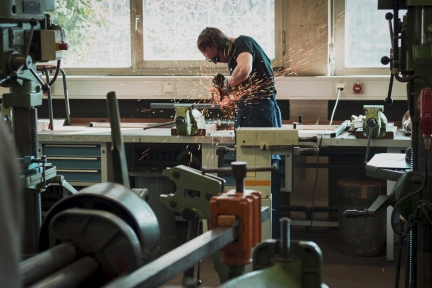
Air emissions
Metal fabrication and finishing businesses perform work regulated by federal and state air regulations, including welding, shot or sand blasting, and painting and coating.
State permits
If abrasive blasting activity is part of your manufacturing or processing, you may need to follow the industrial process equipment rule. For example, blasting may need to be performed in a room or booth where the air is filtered. Use the abrasive blasting calculator to see what is required of your business. The MPCA requires facilities to prevent dust from becoming airborne; airborne dust is a nuisance and a health concern.
Some metal fabrication and finishing operations at your business may not be significant sources of air emissions. When evaluating your air emissions, check the insignificant activities rule to see if your equipment or activities are listed.
- If not, use this calculator to see if your activities qualify as conditionally insignificant and your business may be eligible as an insignificant facility:
- Otherwise, a registration air permit may be the best fit for your business.
In addition to mechanical finishing, businesses using paints, stains, solvents, or other volatile organic compound (VOC) containing materials may need an air permit based on the amount that is used. Using less than 1,000 gallons per year may be considered a conditionally insignificant activity. Using less than 2,000 gallons per year may qualify to operate without a permit by following certain technical standards or apply for a registration option B air permit. If your business uses more than 2,000 gallons of VOC-materials, has a higher air emission potential, or has other activities that emit air pollutants, you may qualify for the Registration Option D permit.
Complying with state permits
Air permit due dates
| Requirement | Due date |
|---|---|
| Emission inventory fee for previous reporting year | Mailed to permit holders between February and April, due within 30 days |
| Emission inventory report | April 1 |
| Emission summary review period | Begins in August/September |
Federal permits
Regardless if your business has an air permit, you may need to meet the requirements of National Emission Standards for Hazardous Air Pollutants (NESHAP)
The Metal Fabrication and Finishing Source Categories (6X) NESHAP focuses on blasting, machining, grinding, painting, and welding activities that release specific metal hazardous air pollutants.
| If this standard applies, submit | Due date |
|---|---|
| Initial notification and first certification of compliance (see compliance section) | 120 days after startup |
| Annual certification of compliance | January 31 |
The Paint Stripping and Miscellaneous Surface Coating Operations (6H) NESHAP affects facilities that spray paint onto metal, wood, or plastic or use methylene chloride to remove paint. Paints and solvents contain VOCs and hazardous air pollutants. If this standard applies, submit the notification and compliance form within 180 day after startup.
The Surface Coating of Miscellaneous Metal Parts and Products (4M) NESHAP affects larger facilities that spray paint onto or coat miscellaneous metal parts. If you have a registration air permit, the 4M NESHAP does not apply to you.
Hazardous waste
You need a hazardous waste identification number if your business produces any amount of hazardous waste.
Businesses generating most types of hazardous waste are required to report annually, pay a fee, and obtain a license for the subsequent year. Facilities in Anoka, Carver, Dakota, Hennepin, Ramsey, Scott, or Washington County are licensed and inspected by their county. Facilities in greater Minnesota are licensed and inspected by the MPCA. If you produce only small amounts of hazardous waste, you probably qualify as a very small quality generator:
Annual hazardous waste training is required for businesses that generate 220 pounds or more of hazardous waste a month. Learn more: Hazardous waste. See the hazardous waste identification and management page for information on managing specific hazardous wastes, such as aerosols, sandblasting and power washing wastes, oil, solvents, paint booth filters, scrap metal, fluorescent lights, and towels and rags
Hazardous waste due dates
| Requirement | Due date |
|---|---|
| Hazardous waste generators fee | Mailed to license holders in first quarter, due date on invoice |
| License application | Due August 15 for Greater Minnesota businesses; Twin Cities metro businesses, contact your county |
Stormwater
Apply for an industrial stormwater permit if you have material, equipment, or activities that are exposed to rain, snow, or runoff. You may qualify for the no-cost no-exposure certification and avoid the permit and fees if you don’t have any materials, equipment, or activities exposed to the elements. If you have only a few materials outside, consider moving them inside to qualify for no-exposure certification. Learn about stormwater pollution prevention ideas for metal fabricators and finishers:
Stormwater permit due dates.
| Requirement | Due date |
|---|---|
| Industrial stormwater general permit annual reporting | March 31 |
| Industrial stormwater general permit quarterly sampling | January 21, April 21, July 21, and October 21 |
Local regulation
Be sure to check with your county, city, and township to see if they have any additional requirements.
Beyond compliance
Create a floor management plan to help you inspect and maintain floors to help prevent the release of hazardous materials.
MnTAP offers many ideas and personalized assistance for reducing wastes and saving energy at metal fabricating and finishing facilities.